John Fowles The French Lieutenant’s Woman

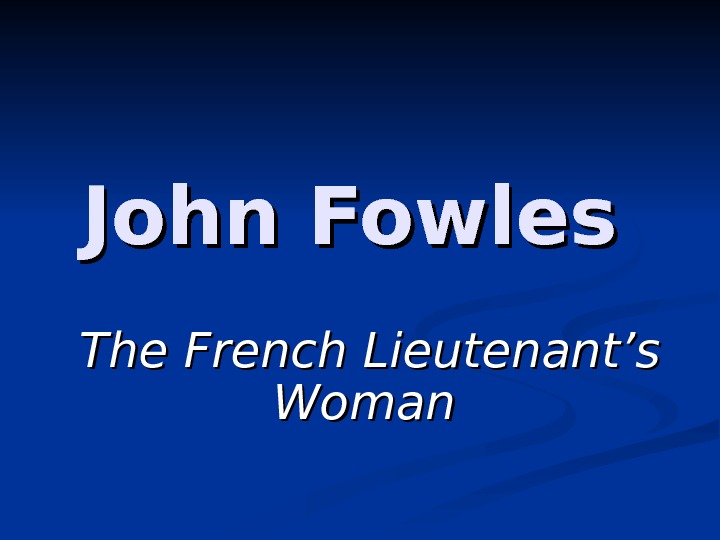



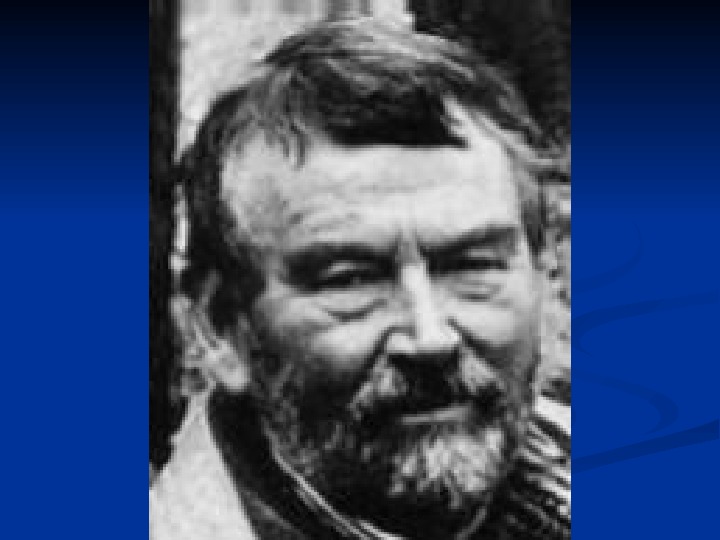
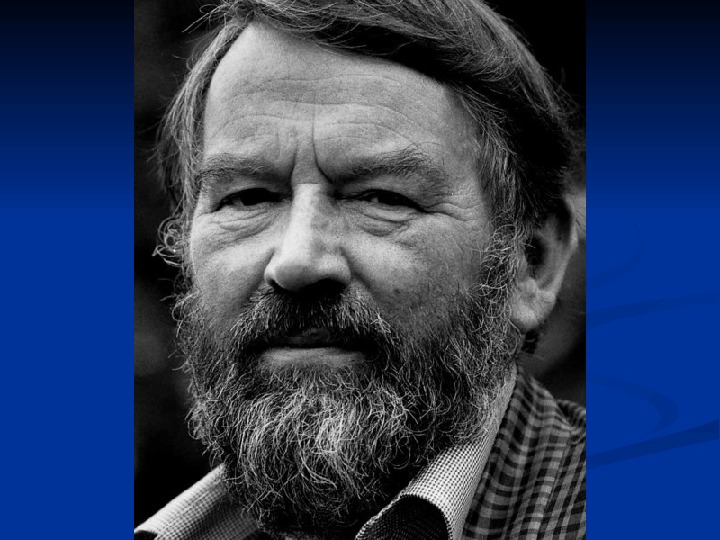
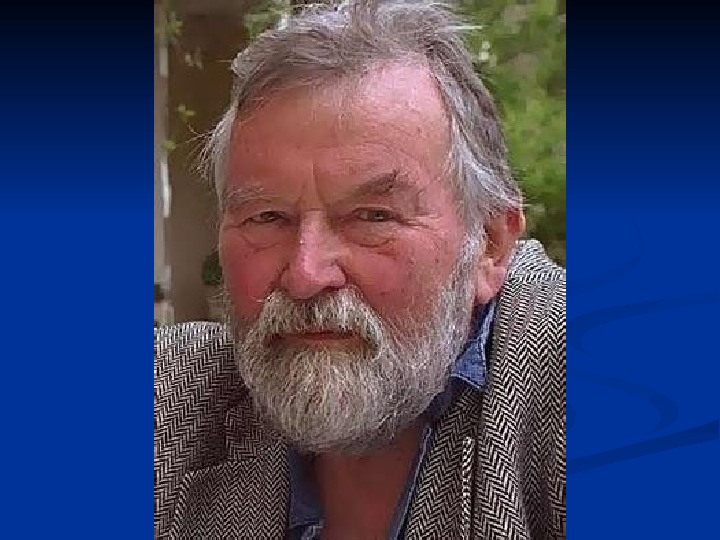
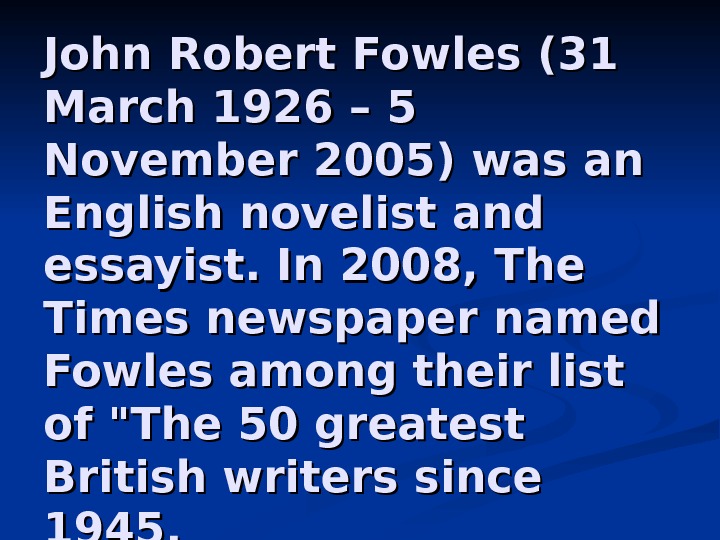



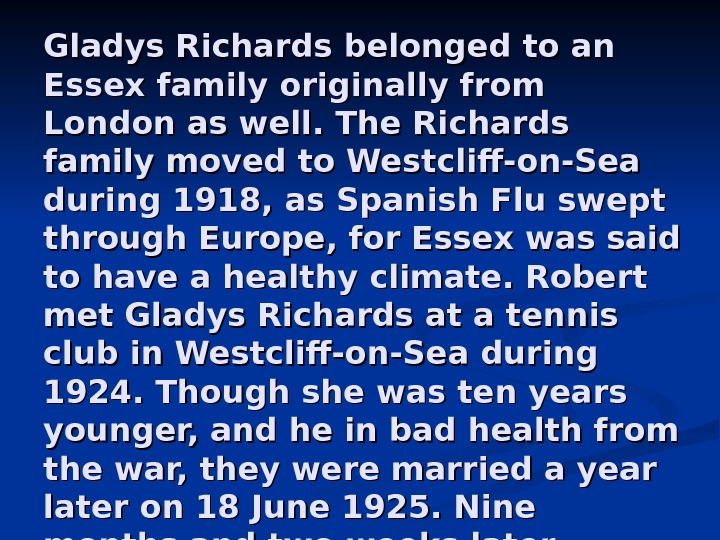


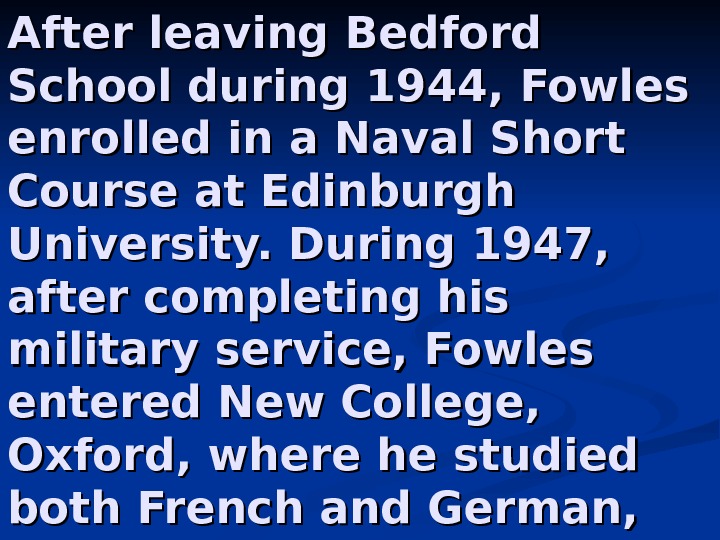

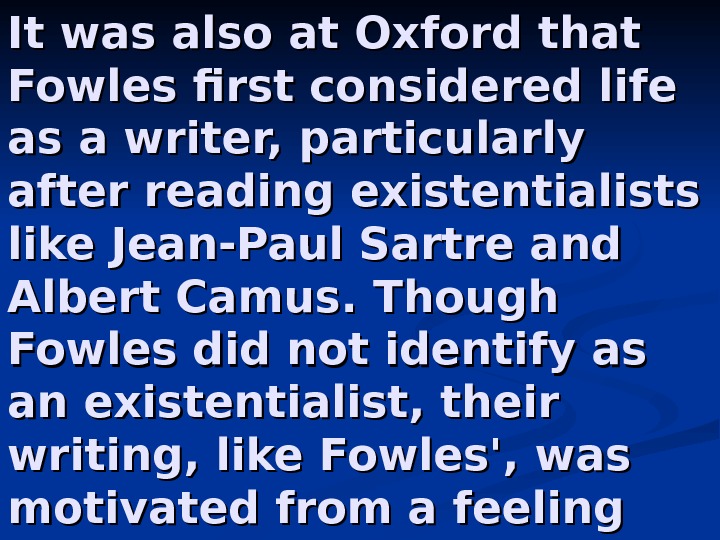

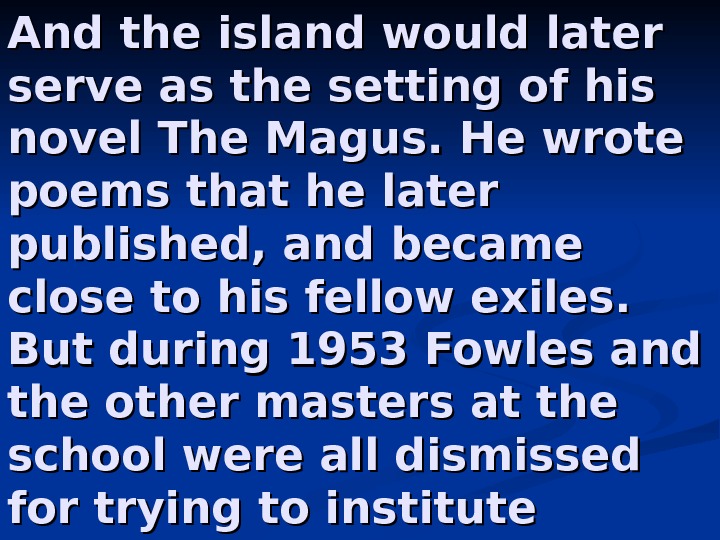
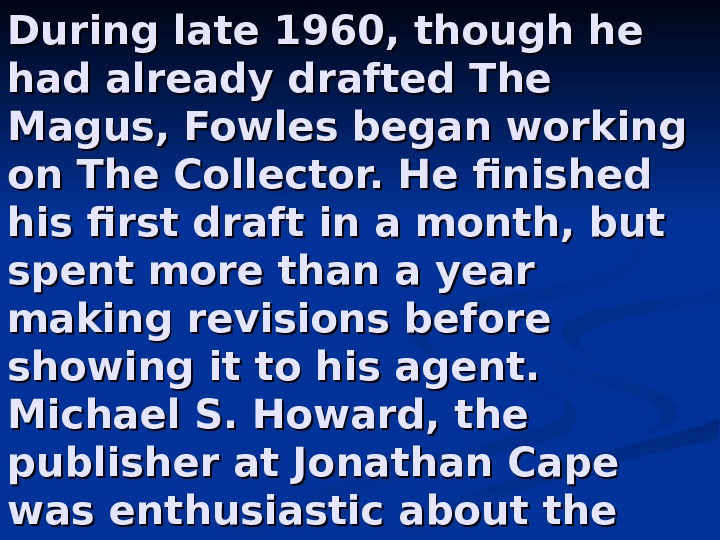

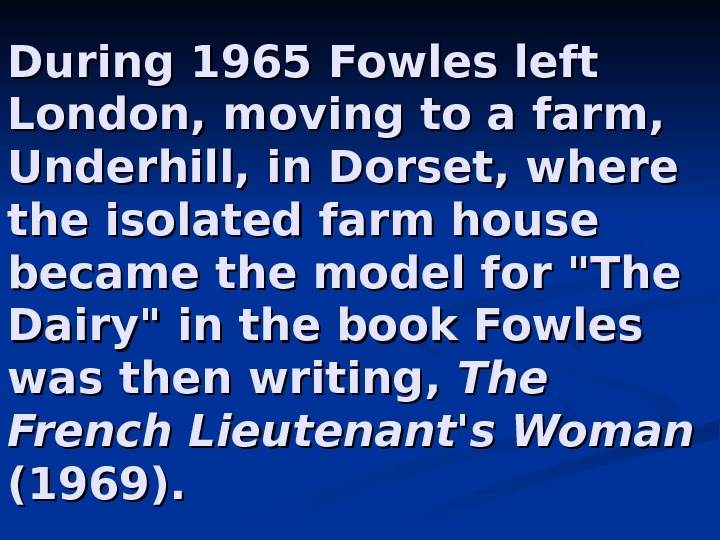
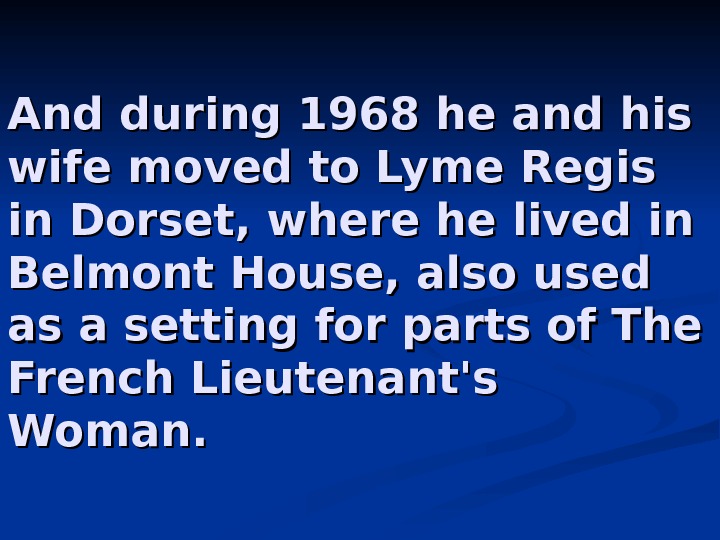
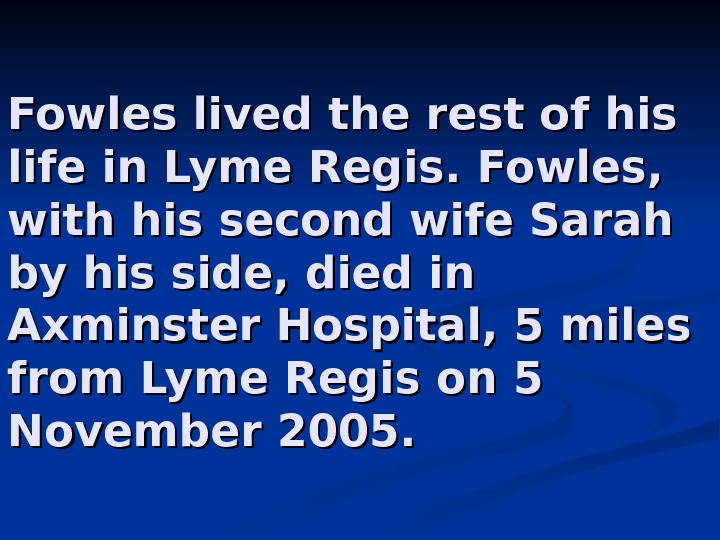

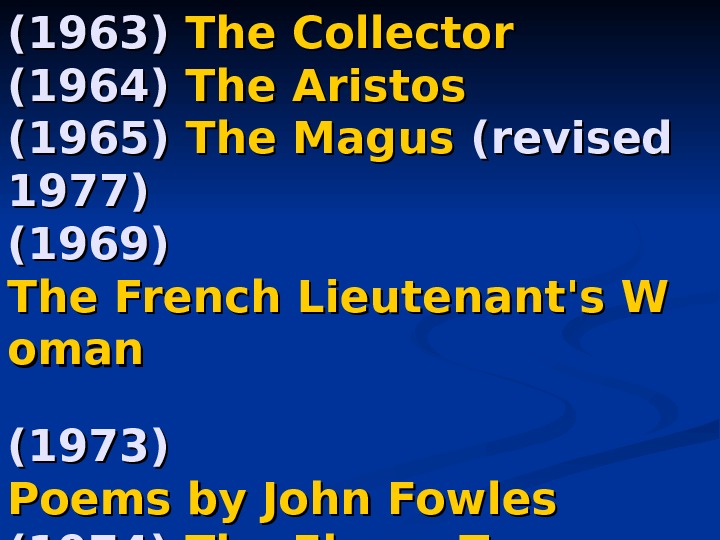
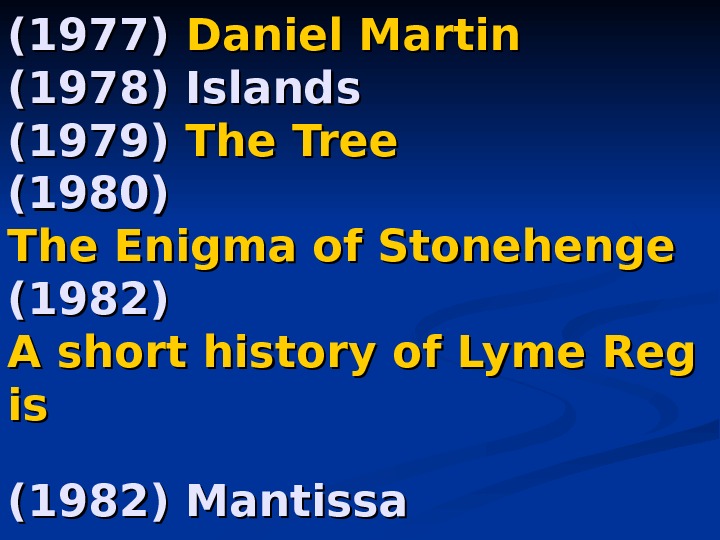
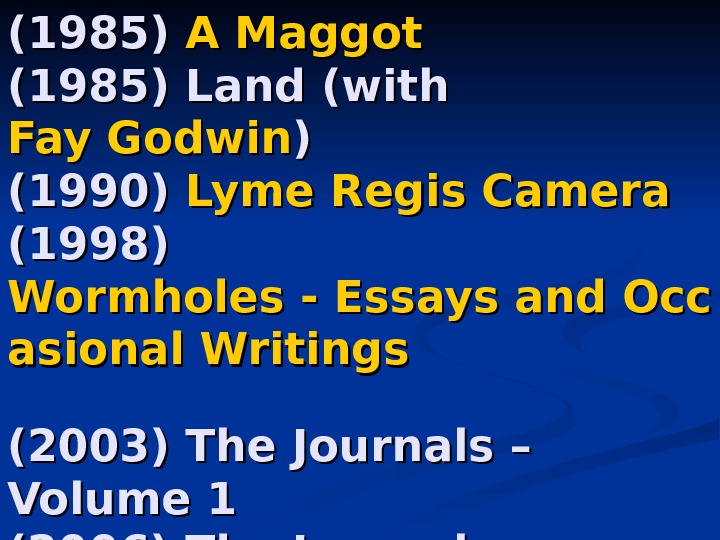


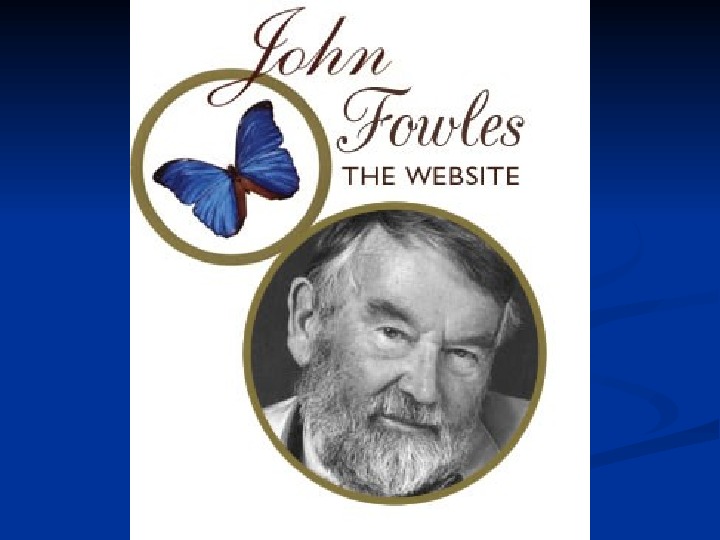
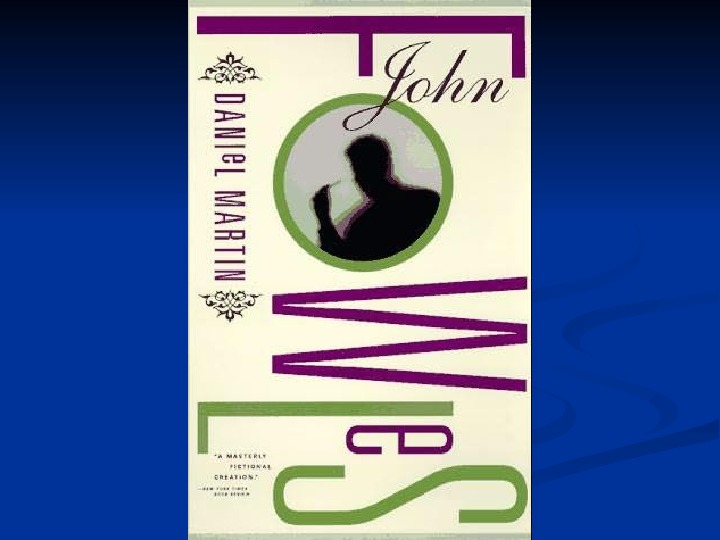
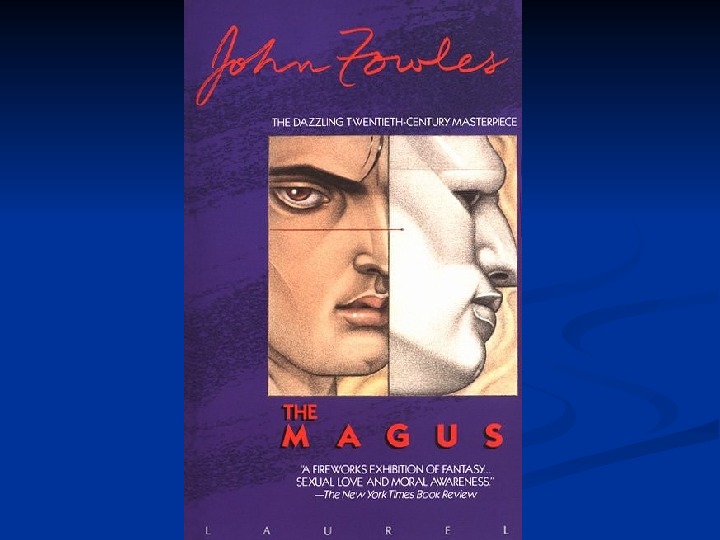
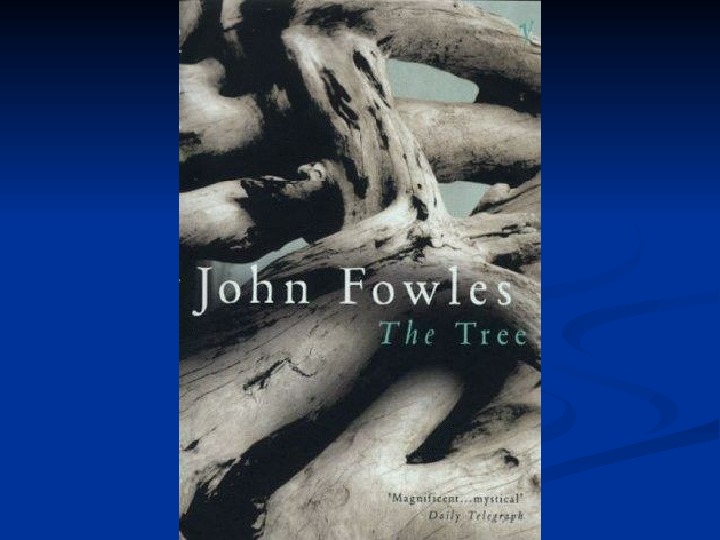


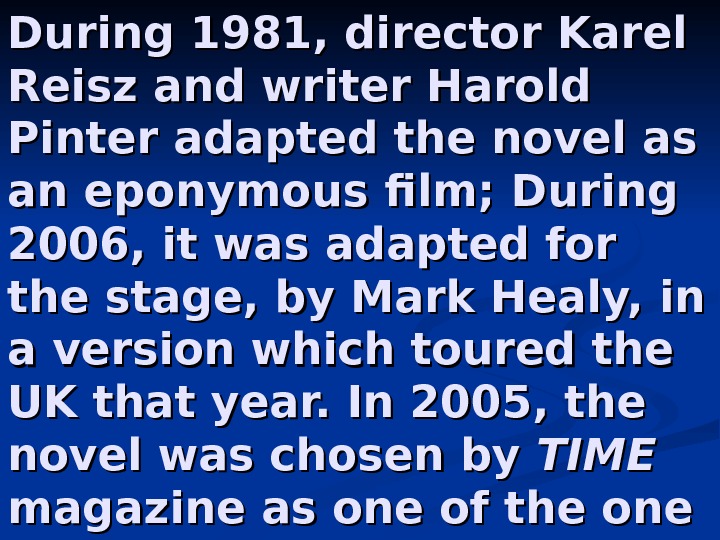
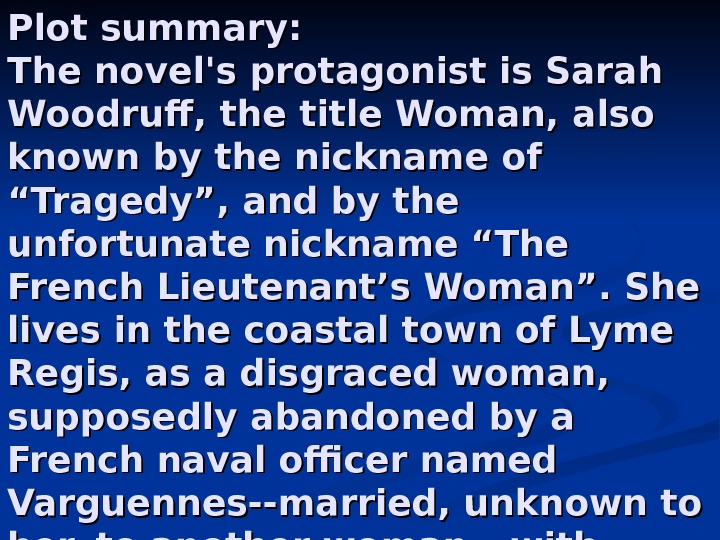
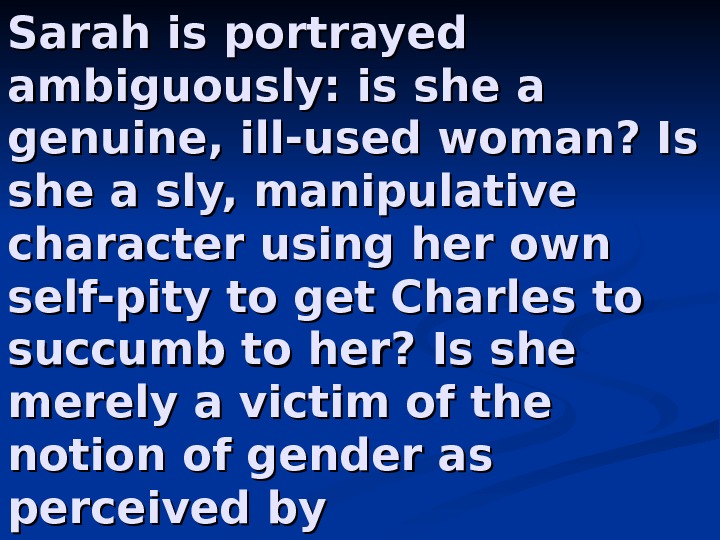
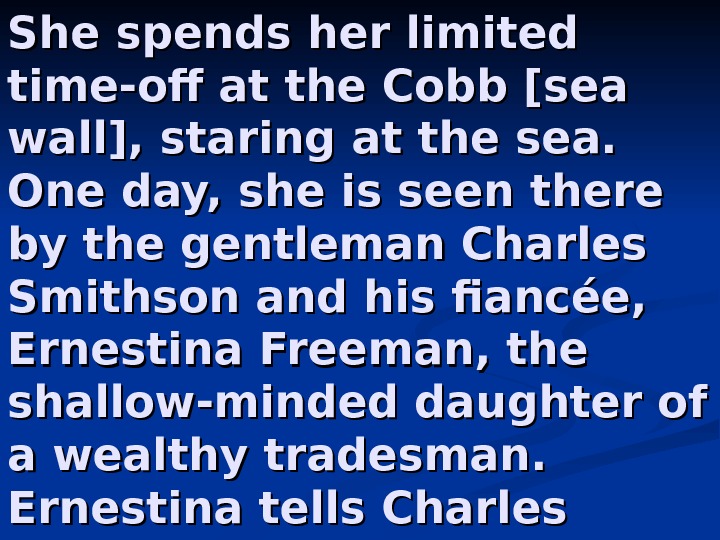
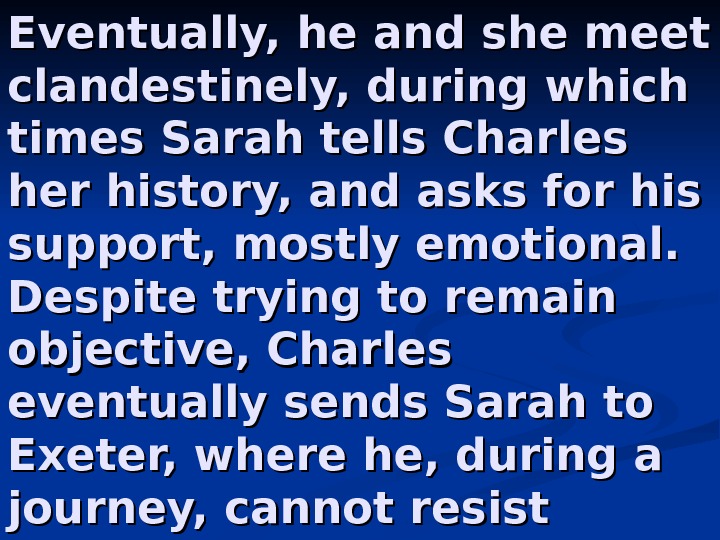
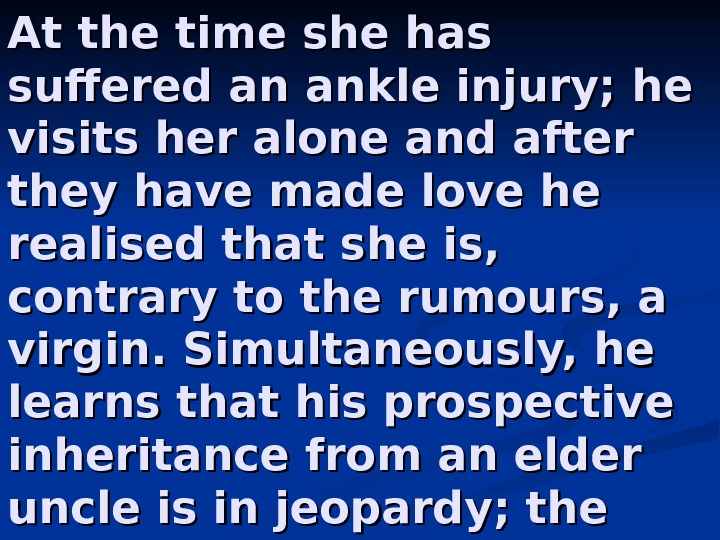



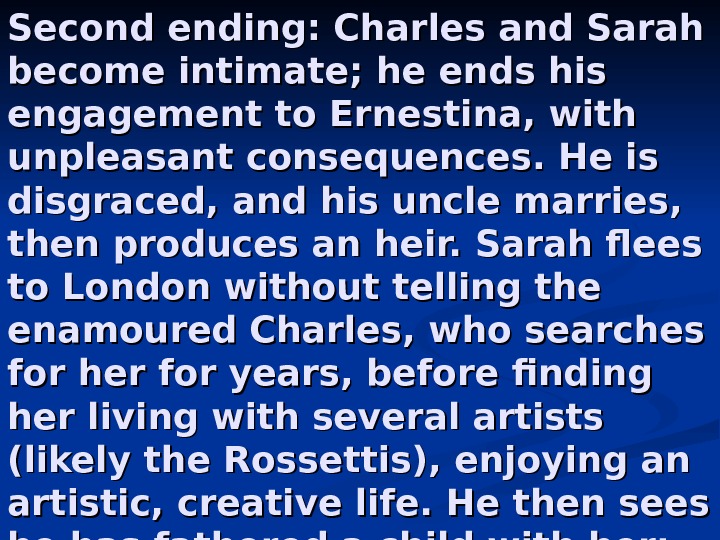


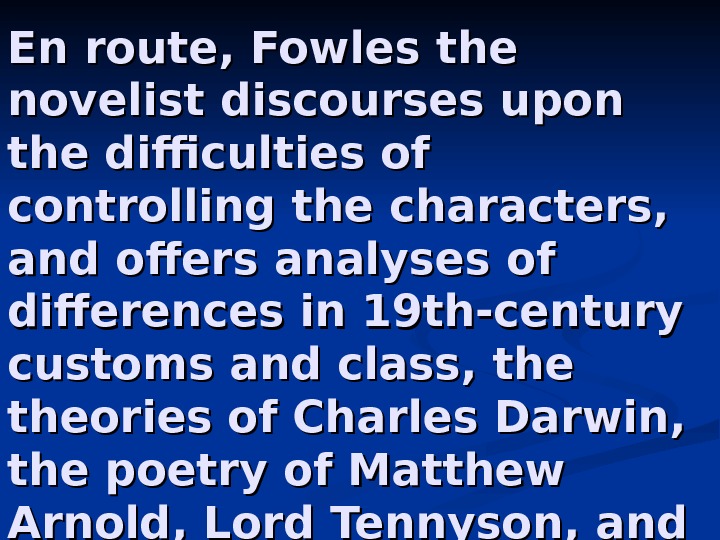

- Размер: 668.5 Кб
- Количество слайдов: 50
Описание презентации John Fowles The French Lieutenant’s Woman по слайдам
 John Fowles The French Lieutenant’s Woman
John Fowles The French Lieutenant’s Woman






 John Robert Fowles (31 March 1926 – 5 November 2005) was an English novelist and essayist. In 2008, The Times newspaper named Fowles among their list of «The 50 greatest British writers since 1945.
John Robert Fowles (31 March 1926 – 5 November 2005) was an English novelist and essayist. In 2008, The Times newspaper named Fowles among their list of «The 50 greatest British writers since 1945.
 Life: Fowles was born in Leigh-on-Sea in Essex, England, the son of Gladys May Richards and Robert John Fowles. Robert Fowles came from a family of middle-class merchants of London. Robert’s father Reginald was a partner of the firm Allen & Wright, a tobacco importer. Robert’s mother died when he was 6 years old.
Life: Fowles was born in Leigh-on-Sea in Essex, England, the son of Gladys May Richards and Robert John Fowles. Robert Fowles came from a family of middle-class merchants of London. Robert’s father Reginald was a partner of the firm Allen & Wright, a tobacco importer. Robert’s mother died when he was 6 years old.
 At age 26, after receiving legal training, Robert enlisted in the Honourable Artillery Company and spent three years in the trenches of Flanders during World War I leaving him with memories that he had for the rest of his life. Robert’s brother Jack died in the war, leaving a widow and three children.
At age 26, after receiving legal training, Robert enlisted in the Honourable Artillery Company and spent three years in the trenches of Flanders during World War I leaving him with memories that he had for the rest of his life. Robert’s brother Jack died in the war, leaving a widow and three children.
 During 1920, the year Robert was demobilized, his father Reginald died. Robert became responsible for five young half-siblings and the children of his brother, and though he had hoped to practice law, the obligation of raising an extended family forced him into the family trade of tobacco importing.
During 1920, the year Robert was demobilized, his father Reginald died. Robert became responsible for five young half-siblings and the children of his brother, and though he had hoped to practice law, the obligation of raising an extended family forced him into the family trade of tobacco importing.
 Gladys Richards belonged to an Essex family originally from London as well. The Richards family moved to Westcliff-on-Sea during 1918, as Spanish Flu swept through Europe, for Essex was said to have a healthy climate. Robert met Gladys Richards at a tennis club in Westcliff-on-Sea during 1924. Though she was ten years younger, and he in bad health from the war, they were married a year later on 18 June 1925. Nine months and two weeks later Gladys gave birth to John Robert Fowles.
Gladys Richards belonged to an Essex family originally from London as well. The Richards family moved to Westcliff-on-Sea during 1918, as Spanish Flu swept through Europe, for Essex was said to have a healthy climate. Robert met Gladys Richards at a tennis club in Westcliff-on-Sea during 1924. Though she was ten years younger, and he in bad health from the war, they were married a year later on 18 June 1925. Nine months and two weeks later Gladys gave birth to John Robert Fowles.
 Fowles spent his childhood attended by his mother and by his cousin Peggy Fowles, 18 years old at the time of his birth, who was his nursemaid and close companion for ten years. Fowles attended Alleyn Court Preparatory School. The work of Richard Jefferies and his character Bevis were Fowles’s favorite books as a child. He was an only child until he was 16 years old.
Fowles spent his childhood attended by his mother and by his cousin Peggy Fowles, 18 years old at the time of his birth, who was his nursemaid and close companion for ten years. Fowles attended Alleyn Court Preparatory School. The work of Richard Jefferies and his character Bevis were Fowles’s favorite books as a child. He was an only child until he was 16 years old.
 During 1939, Fowles won a position at Bedford School, a two-hour train journey north of his home. His time at Bedford coincided with the Second World War. Fowles was a student at Bedford until 1944. He became Head Boy and was also an athletic standout: a member of the rugby-football third team, the Fives first team and captain of the cricket team, for which he was bowler.
During 1939, Fowles won a position at Bedford School, a two-hour train journey north of his home. His time at Bedford coincided with the Second World War. Fowles was a student at Bedford until 1944. He became Head Boy and was also an athletic standout: a member of the rugby-football third team, the Fives first team and captain of the cricket team, for which he was bowler.
 After leaving Bedford School during 1944, Fowles enrolled in a Naval Short Course at Edinburgh University. During 1947, after completing his military service, Fowles entered New College, Oxford, where he studied both French and German, although he stopped studying German and concentrated on French for his BA.
After leaving Bedford School during 1944, Fowles enrolled in a Naval Short Course at Edinburgh University. During 1947, after completing his military service, Fowles entered New College, Oxford, where he studied both French and German, although he stopped studying German and concentrated on French for his BA.
 Fowles was undergoing a political transformation. Upon leaving the marines he wrote, «I. . . began to hate what I was becoming in life—- a British Establishment young hopeful. I decided instead to become a sort of anarchist. «
Fowles was undergoing a political transformation. Upon leaving the marines he wrote, «I. . . began to hate what I was becoming in life—- a British Establishment young hopeful. I decided instead to become a sort of anarchist. «
 It was also at Oxford that Fowles first considered life as a writer, particularly after reading existentialists like Jean-Paul Sartre and Albert Camus. Though Fowles did not identify as an existentialist, their writing, like Fowles’, was motivated from a feeling that the world was wrong.
It was also at Oxford that Fowles first considered life as a writer, particularly after reading existentialists like Jean-Paul Sartre and Albert Camus. Though Fowles did not identify as an existentialist, their writing, like Fowles’, was motivated from a feeling that the world was wrong.
 Fowles spent his early adult life as a teacher. His first year after Oxford was spent at the University of Poitiers. During 1951, Fowles became an English master at the Anargyrios and Korgialenios School of Spetses on the Peloponnesian island of Spetsai, a critical part of Fowles’s life, as the island would be where he met his future wife Elizabeth Christy.
Fowles spent his early adult life as a teacher. His first year after Oxford was spent at the University of Poitiers. During 1951, Fowles became an English master at the Anargyrios and Korgialenios School of Spetses on the Peloponnesian island of Spetsai, a critical part of Fowles’s life, as the island would be where he met his future wife Elizabeth Christy.
 And the island would later serve as the setting of his novel The Magus. He wrote poems that he later published, and became close to his fellow exiles. But during 1953 Fowles and the other masters at the school were all dismissed for trying to institute reforms, and Fowles returned to England.
And the island would later serve as the setting of his novel The Magus. He wrote poems that he later published, and became close to his fellow exiles. But during 1953 Fowles and the other masters at the school were all dismissed for trying to institute reforms, and Fowles returned to England.
 During late 1960, though he had already drafted The Magus, Fowles began working on The Collector. He finished his first draft in a month, but spent more than a year making revisions before showing it to his agent. Michael S. Howard, the publisher at Jonathan Cape was enthusiastic about the manuscript. The book was published during 1963 and when the paperback rights
During late 1960, though he had already drafted The Magus, Fowles began working on The Collector. He finished his first draft in a month, but spent more than a year making revisions before showing it to his agent. Michael S. Howard, the publisher at Jonathan Cape was enthusiastic about the manuscript. The book was published during 1963 and when the paperback rights
 were sold in the spring of that year it was «probably the highest price that had hitherto been paid for a first novel, » according to Howard. The success of his novel meant that Fowles was able to stop teaching and devote himself full-time to a literary career. The Collector was also optioned and became a film in 1965.
were sold in the spring of that year it was «probably the highest price that had hitherto been paid for a first novel, » according to Howard. The success of his novel meant that Fowles was able to stop teaching and devote himself full-time to a literary career. The Collector was also optioned and became a film in 1965.
 During 1965 Fowles left London, moving to a farm, Underhill, in Dorset, where the isolated farm house became the model for «The Dairy» in the book Fowles was then writing, The French Lieutenant’s Woman (1969).
During 1965 Fowles left London, moving to a farm, Underhill, in Dorset, where the isolated farm house became the model for «The Dairy» in the book Fowles was then writing, The French Lieutenant’s Woman (1969).
 And during 1968 he and his wife moved to Lyme Regis in Dorset, where he lived in Belmont House, also used as a setting for parts of The French Lieutenant’s Woman.
And during 1968 he and his wife moved to Lyme Regis in Dorset, where he lived in Belmont House, also used as a setting for parts of The French Lieutenant’s Woman.
 Fowles lived the rest of his life in Lyme Regis. Fowles, with his second wife Sarah by his side, died in Axminster Hospital, 5 miles from Lyme Regis on 5 November 2005.
Fowles lived the rest of his life in Lyme Regis. Fowles, with his second wife Sarah by his side, died in Axminster Hospital, 5 miles from Lyme Regis on 5 November 2005.
 Major Works
Major Works
 (1963) The Collector (1964) The Aristos (1965) The Magus (revised 1977) (1969) The French Lieutenant’s W oman (1973) Poems by John Fowles (1974) The Ebony Tower (1974) Shipwreck by John Fowles
(1963) The Collector (1964) The Aristos (1965) The Magus (revised 1977) (1969) The French Lieutenant’s W oman (1973) Poems by John Fowles (1974) The Ebony Tower (1974) Shipwreck by John Fowles
 (1977) Daniel Martin (1978) Islands (1979) The Tree (1980) The Enigma of Stonehenge (1982) A short history of Lyme Reg isis (1982) Mantissa
(1977) Daniel Martin (1978) Islands (1979) The Tree (1980) The Enigma of Stonehenge (1982) A short history of Lyme Reg isis (1982) Mantissa
 (1985) A Maggot (1985) Land (with Fay Godwin ) ) (1990) Lyme Regis Camera (1998) Wormholes — Essays and Occ asional Writings (2003) The Journals – Volume 1 (2006) The Journals – Volume
(1985) A Maggot (1985) Land (with Fay Godwin ) ) (1990) Lyme Regis Camera (1998) Wormholes — Essays and Occ asional Writings (2003) The Journals – Volume 1 (2006) The Journals – Volume






 The French Lieutenant’s Woman
The French Lieutenant’s Woman
 The French Lieutenant’s Woman (1969), by John Fowles, is a period novel inspired by the 1823 novel Ourika, by Claire de Duras, which Fowles translated to English during 1977 (and revised in 1994). He was a great aficionado of Thomas Hardy, and, in particular, likened his heroine, Sarah Woodruff, to Tess Durbeyfield, the protagonist of Hardy’s popular novel Tess of the d’Urbervilles (1891).
The French Lieutenant’s Woman (1969), by John Fowles, is a period novel inspired by the 1823 novel Ourika, by Claire de Duras, which Fowles translated to English during 1977 (and revised in 1994). He was a great aficionado of Thomas Hardy, and, in particular, likened his heroine, Sarah Woodruff, to Tess Durbeyfield, the protagonist of Hardy’s popular novel Tess of the d’Urbervilles (1891).
 During 1981, director Karel Reisz and writer Harold Pinter adapted the novel as an eponymous film; During 2006, it was adapted for the stage, by Mark Healy, in a version which toured the UK that year. In 2005, the novel was chosen by TIME magazine as one of the one hundred best English-language novels from 1923 to present.
During 1981, director Karel Reisz and writer Harold Pinter adapted the novel as an eponymous film; During 2006, it was adapted for the stage, by Mark Healy, in a version which toured the UK that year. In 2005, the novel was chosen by TIME magazine as one of the one hundred best English-language novels from 1923 to present.
 Plot summary: The novel’s protagonist is Sarah Woodruff, the title Woman, also known by the nickname of “Tragedy”, and by the unfortunate nickname “The French Lieutenant’s Woman”. She lives in the coastal town of Lyme Regis, as a disgraced woman, supposedly abandoned by a French naval officer named Varguennes—married, unknown to her, to another woman— with whom she had supposedly had an affair and who had returned to France.
Plot summary: The novel’s protagonist is Sarah Woodruff, the title Woman, also known by the nickname of “Tragedy”, and by the unfortunate nickname “The French Lieutenant’s Woman”. She lives in the coastal town of Lyme Regis, as a disgraced woman, supposedly abandoned by a French naval officer named Varguennes—married, unknown to her, to another woman— with whom she had supposedly had an affair and who had returned to France.
 Sarah is portrayed ambiguously: is she a genuine, ill-used woman? Is she a sly, manipulative character using her own self-pity to get Charles to succumb to her? Is she merely a victim of the notion of gender as perceived by upper-middle-class people of the 19 th century?
Sarah is portrayed ambiguously: is she a genuine, ill-used woman? Is she a sly, manipulative character using her own self-pity to get Charles to succumb to her? Is she merely a victim of the notion of gender as perceived by upper-middle-class people of the 19 th century?
![She spends her limited time-off at the Cobb [sea wall], staring at the sea. She spends her limited time-off at the Cobb [sea wall], staring at the sea.](/docs//john_fowles_1_images/john_fowles_1_39.jpg) She spends her limited time-off at the Cobb [sea wall], staring at the sea. One day, she is seen there by the gentleman Charles Smithson and his fiancée, Ernestina Freeman, the shallow-minded daughter of a wealthy tradesman. Ernestina tells Charles something of Sarah’s story, and he develops a strong curiosity about her.
She spends her limited time-off at the Cobb [sea wall], staring at the sea. One day, she is seen there by the gentleman Charles Smithson and his fiancée, Ernestina Freeman, the shallow-minded daughter of a wealthy tradesman. Ernestina tells Charles something of Sarah’s story, and he develops a strong curiosity about her.
 Eventually, he and she meet clandestinely, during which times Sarah tells Charles her history, and asks for his support, mostly emotional. Despite trying to remain objective, Charles eventually sends Sarah to Exeter, where he, during a journey, cannot resist stopping in to visit and see her.
Eventually, he and she meet clandestinely, during which times Sarah tells Charles her history, and asks for his support, mostly emotional. Despite trying to remain objective, Charles eventually sends Sarah to Exeter, where he, during a journey, cannot resist stopping in to visit and see her.
 At the time she has suffered an ankle injury; he visits her alone and after they have made love he realised that she is, contrary to the rumours, a virgin. Simultaneously, he learns that his prospective inheritance from an elder uncle is in jeopardy; the uncle is engaged to a woman young enough to bear him an heir.
At the time she has suffered an ankle injury; he visits her alone and after they have made love he realised that she is, contrary to the rumours, a virgin. Simultaneously, he learns that his prospective inheritance from an elder uncle is in jeopardy; the uncle is engaged to a woman young enough to bear him an heir.
 From there, the novelist offers three different endings for The French Lieutenant’s Woman.
From there, the novelist offers three different endings for The French Lieutenant’s Woman.
 First ending: Charles marries Ernestina, and their marriage is unhappy; Sarah’s fate is unknown. Charles tells Ernestina about an encounter with whom he implies is the “French Lieutenant’s Whore”, but elides the sordid details, and the matter is ended. This ending, however, might be dismissed as a daydream, before the alternative events of the subsequent meeting with Ernestina are described.
First ending: Charles marries Ernestina, and their marriage is unhappy; Sarah’s fate is unknown. Charles tells Ernestina about an encounter with whom he implies is the “French Lieutenant’s Whore”, but elides the sordid details, and the matter is ended. This ending, however, might be dismissed as a daydream, before the alternative events of the subsequent meeting with Ernestina are described.
 Before the second- and third endings, the narrator — whom the novelist wants the reader to believe is John Fowles, himself — appears as a minor character sharing a train carriage with Charles. He flips a coin to determine the order in which he will portray the two, other possible endings, emphasising their equal plausibility.
Before the second- and third endings, the narrator — whom the novelist wants the reader to believe is John Fowles, himself — appears as a minor character sharing a train carriage with Charles. He flips a coin to determine the order in which he will portray the two, other possible endings, emphasising their equal plausibility.
 Second ending: Charles and Sarah become intimate; he ends his engagement to Ernestina, with unpleasant consequences. He is disgraced, and his uncle marries, then produces an heir. Sarah flees to London without telling the enamoured Charles, who searches for her for years, before finding her living with several artists (likely the Rossettis), enjoying an artistic, creative life. He then sees he has fathered a child with her; as a family, their future is open, with possible reunion implied.
Second ending: Charles and Sarah become intimate; he ends his engagement to Ernestina, with unpleasant consequences. He is disgraced, and his uncle marries, then produces an heir. Sarah flees to London without telling the enamoured Charles, who searches for her for years, before finding her living with several artists (likely the Rossettis), enjoying an artistic, creative life. He then sees he has fathered a child with her; as a family, their future is open, with possible reunion implied.
 Third ending: the narrator re-appears, standing outside the house where the second ending occurred; at the aftermath. He turns back his pocket watch by fifteen minutes, before leaving in his carriage. Events are the same as in the second-ending version, but, when Charles finds Sarah again, in London, their reunion is sour.
Third ending: the narrator re-appears, standing outside the house where the second ending occurred; at the aftermath. He turns back his pocket watch by fifteen minutes, before leaving in his carriage. Events are the same as in the second-ending version, but, when Charles finds Sarah again, in London, their reunion is sour.
 It is possible that their union was childless; Sarah does not tell Charles about one, and does not express interest for continuing the relationship. He leaves the house, deciding to return to America, and sees the carriage, in which the narrator was thought gone. Raising the question: is Sarah a manipulating, lying woman of few morals, exploiting Charles’s obvious love to get what she wants?
It is possible that their union was childless; Sarah does not tell Charles about one, and does not express interest for continuing the relationship. He leaves the house, deciding to return to America, and sees the carriage, in which the narrator was thought gone. Raising the question: is Sarah a manipulating, lying woman of few morals, exploiting Charles’s obvious love to get what she wants?
 En route, Fowles the novelist discourses upon the difficulties of controlling the characters, and offers analyses of differences in 19 th-century customs and class, the theories of Charles Darwin, the poetry of Matthew Arnold, Lord Tennyson, and the literature of Thomas Hardy.
En route, Fowles the novelist discourses upon the difficulties of controlling the characters, and offers analyses of differences in 19 th-century customs and class, the theories of Charles Darwin, the poetry of Matthew Arnold, Lord Tennyson, and the literature of Thomas Hardy.
 He questions the role of the author — when speaking of how the Charles character “disobeys” his orders; the characters have discrete lives of their own in the novel. Philosophically, Existentialism is mentioned several times during the story, and in particular detail at the end, after the portrayals of the two, apparent, equally possible endings.
He questions the role of the author — when speaking of how the Charles character “disobeys” his orders; the characters have discrete lives of their own in the novel. Philosophically, Existentialism is mentioned several times during the story, and in particular detail at the end, after the portrayals of the two, apparent, equally possible endings.

